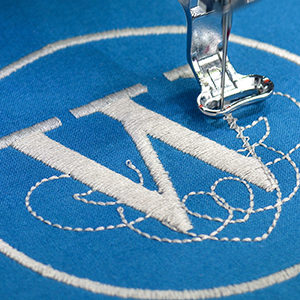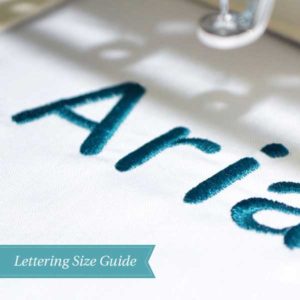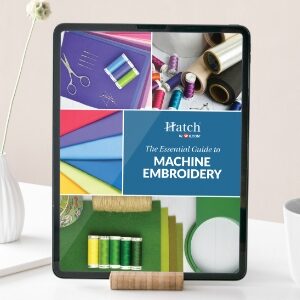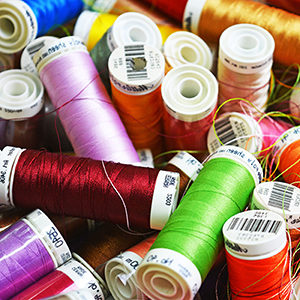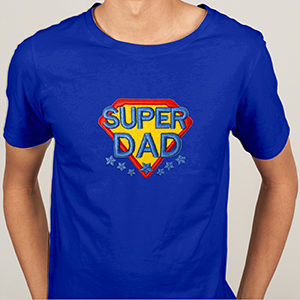The perfect guide to choosing the right stabilizer for your embroidery projects

Choosing stabilizers can be tricky. Make the wrong choice and your final stitch-out could end up completely different to what you planned! That is why we put together an overview on the different types of stabilizers and which one to choose for your embroidery projects.
What is a Stabilizer?
Stabilizers are often stiff sheets placed over (topping) or, more frequently, underneath (backing) your designs. In this article we cover the three main types of backing type stabilizers (cut-away, tear-away and wash-away) as well as two additional stabilizers that are a little less universal (heat-away and spray-on).
Stabilizers help minimize a variety of issues including, but not limited to; puckering, stretching, uneven lines, crooked or mismatched stitching and sinking. This happens because many materials, cloth materials especially, can easily shift and bunch up as they lack the stiffness of other materials, like leather. This leaves a wider margin for error, especially if your fabrics are lighter. Placing a stabilizer underneath your fabric cuts down this movement and gives you a more steady canvas to work on.
Backing vs Topping Stabilizers
Backing and topping both fall under the category of stabilizers for machine embroidery and are just what their names suggest. Topping is typically placed over your design with the main purpose of preventing stitching from “sinking” into your fabric. Generally topping is only used with fabrics that are more “stitch absorbent” or textured, and they typically come in wash-away and tear-away types. Backing, on the other hand, is recommended for every fabric, with very few exceptions. Backing helps your fabric maintain its physical and structural integrity while being embroidered, and also allows your designs to keep their shape after being laundered. The focus of this blog post will be on backing stabilizers.

Determining Which Stabilizer to Use
Before starting you will need to consider the type of fabric you plan to embroider, specifically fabric stability, fabric density and stitch density. These three factors are the most important when selecting the right stabilizer. With denser stitch counts, the stabilizer needs to be sturdier. The less stable the fabric, the more stability you will need. The heavier the fabric, the heavier the stabilizer ought to be. Some fabrics may require two stabilizers, some may require none. Standard fabrics will usually just require one type of stabilizer. Your embroidery fabric is always your starting point so make sure you do your research on what stabilizers are compatible with your fabric.
Cut-Away Stabilizers
Cut-away stabilizers do not get totally removed upon completion, instead the excess is trimmed and the stabilizer stays attached to the fabric. They are quite versatile and are great especially for delicates, with the exception of silk. They are an absolute must with stretchy or knit type materials. Many people prefer cut-away stabilizers for garments, because there are no jagged edges that can irritate the skin. For sheer or loose-knit materials use a polyester or nylon mesh cut-away stabilizer. These are made specifically to be invisible through sheer fabrics.

Tear-Away Stabilizers
Tear-away stabilizers are a great, cost-effective option and are the quickest and easiest to remove. They are simply adhered to the back of your embroidery design during embroidery with stitches, and then torn right off. These are best used with a sturdier fabric as the act of tearing may be a little bit harsh for more delicate fabrics. They do not provide as much support as cut-away stabilizer, and you would not hoop them as they are quite rigid. Instead you can slide them under your hooped fabric after you attached the hoop to your machine. Tear-away stabilizers are categorized by weight, as most stabilizers are, so when you are working with heavier fabrics, a heavy weight tear-away stabilizer is required.
Wash-Away Stabilizers
Water soluble stabilizers are less universally used than cut-away or tear-away stabilizers. They are known for their flexibility, transparency and water solubility, so they are best for cases where your project requires no traces of the stabilizer to be left after embroidery. They are often considered the perfect ‘invisible’ stabilizer, and are mostly used with either more delicate, sheer materials, pieces that require constant wash-and-wear and stand-alone lace designs.

Heat-Away Stabilizers
One of the go-to stabilizers for fussier fabrics, heat-away stabilizers is perfect for pieces that are too delicate for tear-aways, too sheer for cut-away and non-washable lace. There are two types (woven and filmy backed). The woven stabilizers will flake off with heat and the filmy stabilizers will dissolve completely. Like wash-away stabilizers, heat-away stabilizers are less universally applicable than the standard cut or tear-away stabilizer as they do not provide as much support.
Spray-On Stabilizers
A modern type of ‘invisible’ stabilizer, spray-on stabilizers are used to stiffen fabric temporarily without the use of any additional material. Spray-on stabilizers are perhaps one of the most convenient types, however, it is important to note that they are best suited for lighter, non-stretch fabrics that have less need for serious stabilization. Many embroiderers also avoid spray-on stabilizers when it comes to expensive materials, like raw silk, but this is simply an extra pre-caution.
Practice Makes Perfect!
The one thing you need to do over and over again is practice. It is not unusual to use the wrong type of stabilizer at first (if you didn’t – congratulations are in order!). I suggest keeping a notebook and pasting good and bad samples and making notes as you complete your projects as to what worked and what did not. It will take some getting used to, and remember, repetition is the key to getting it right in the end!
Downloadable Stabilizer Guide
We have prepared a printable stabilizer reference guide for you. It will give you tips when you should use each type of stabilizer, which weight of stabilizer should you use and much more. You will want to keep this guide handy in your sewing room!
Hatch Embroidery software products are in popular use in over 100 countries. It is time to join the global trend and give Hatch a try! The 30-Day Free Trial grants you unlimited use of all the amazing features and the 30-Day Money-Back Guarantee ensures that there is absolutely no risk involved.








